Houseplant Pests and Diseases
How to keep indoor plants healthy and pest-free
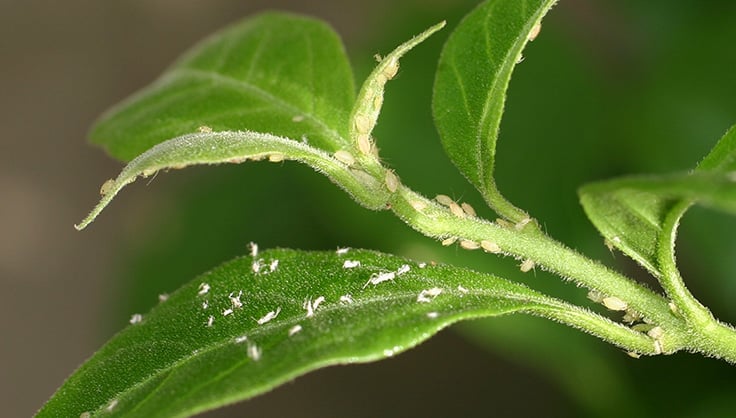 One of the most common indoor plant pests, aphids tend to congregate on new growth where they suck plant juices and secrete sticky "honeydew."
One of the most common indoor plant pests, aphids tend to congregate on new growth where they suck plant juices and secrete sticky "honeydew."Some gardeners find growing a great tomato or a beautiful bed of zinnias is easier than keeping houseplants alive. It seems that one day they're fine and the next they're dropping leaves and are infested with pests.
It's actually not that difficult to keep houseplants happy, but you do need to pay attention to their basic needs, and take care of any pest problems right away.
5 Quick Tips for Keeping Houseplants Healthy
- Inspect plants before bringing them indoors -- whether they're newly purchased or they've spent the summer outdoors. If they show signs of pests or disease, keep them isolated and cure the problem before you infect your other indoor plants.
- Expect new plants to drop some leaves or otherwise show symptoms of shock as you move them from the nursery to your home — especially if light levels in your home are significantly different.
- Avoid placing plants in trouble spots, where temperature fluctuate or stay too warm or too cold. For example, locate them away from heating and air conditioning ducts, and don't put them on top of a radiator, or between curtains and a frosty window.
- Provide the right light. Plants that prefer bright light will thrive in a south-facing window. East-and west-facing windows have moderate sun. North windows have very little sun. Plants that require high light levels will do best under a grow light.
- Remember that heating systems can dry out the air in winter. You can provide a little extra humidity with a pebble tray and some misting.
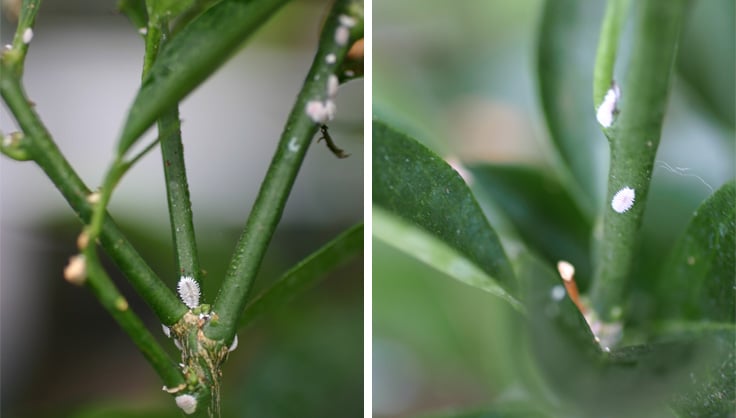 Individual mealybugs are oval-shaped, but you'll often see white masses, especially in the axil where a leaf meets a stem. The insects are hidden underneath, protected by the waxy, cottony covering they secrete.
Individual mealybugs are oval-shaped, but you'll often see white masses, especially in the axil where a leaf meets a stem. The insects are hidden underneath, protected by the waxy, cottony covering they secrete.
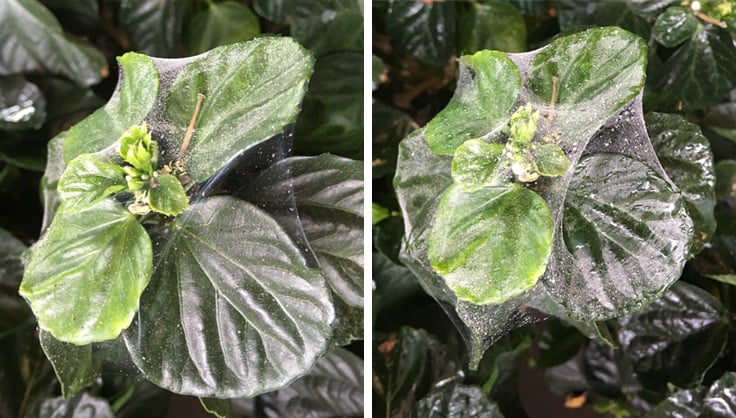 Spidermites are tiny and difficult to see, but their webs give them away. Look for delicate webs, especially on new growth. Spritzing plants with a fine mist (shown right) helps reveal the pests, as the water clings to the webs.
Spidermites are tiny and difficult to see, but their webs give them away. Look for delicate webs, especially on new growth. Spritzing plants with a fine mist (shown right) helps reveal the pests, as the water clings to the webs.
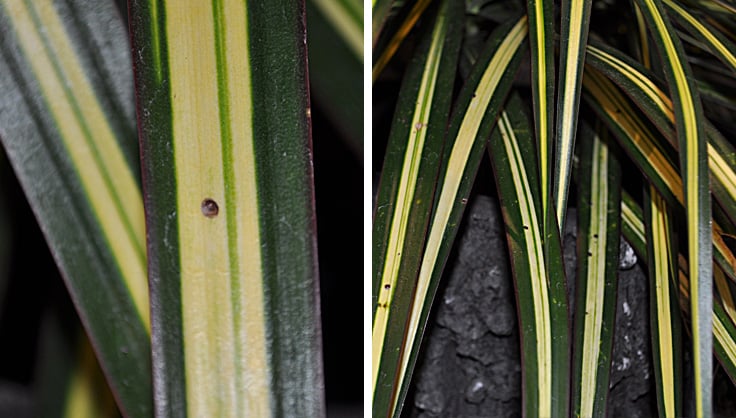 Scale insects are particularly difficult to see. They resemble small bumps which can look like they're a part of the plant. So plants may end up heavily infested before their presence is noted. One clue is the sticky honeydew they secrete.
Scale insects are particularly difficult to see. They resemble small bumps which can look like they're a part of the plant. So plants may end up heavily infested before their presence is noted. One clue is the sticky honeydew they secrete.
The number one way to prevent pest propblems is to optimize your plants' health. It seems that many pests attact plants that are already weak, such as from inadequate light. Below are some general guidelines for controlling houseplant pests. Find more details in these articles:
Know Your Plants
All plants need food, water and sunlight to survive, but different plants require different amounts of each. This is just as true with houseplants as it is for the plants in your garden. For example, ficus trees generally thrive with bright, indirect light and moist soil, whereas cacti require bright light and dry soil.
Take care to choose houseplants that will thrive on the amount of light you can provide. Healthy plants will be able to ward off pests and disease much better than weak plants. If you want to grow plants with high light needs, consider purchasing a grow light.
Indoor plants also need regular fertilizing to maintain healthy growth. Plant Health Care for Seedlings and Houseplants is a good all-around fertilizer that can be added right to your watering can. It contains a 6-12-6 fertilizer, humic and amino acids, and vitamins. As a general rule, most houseplants should be fertilized from January through September, and should then be allowed to "rest" for a few months. (Specific plants may need a different fertilizing regimen.)
Provide Consistent Water
Alternating periods of drought and flood can really stress a plant’s root system. Most plants like having their roots consistently moist, but not wet. Some plants prefer to dry out a bit between waterings. For new plants, check the care label or consult a good indoor plant book. This will help you determine the right watering routine. Self-watering planters make it easier to keep plants watered. Avoid watering on a schedule, such as once a week. Rather, stick your finger in the soil to check soil moisture!
Prevent Pest Problems
Check houseplants for disease or insects before you buy them. Then isolate them for a couple weeks, just to make sure there are no problems. Each time you water your plants, inspect both the top and undersides of the leaves for signs of pests or disease. If you suspect anything, isolate the plant from your other plants until you have eliminated the problem.
It is also a good idea to wash the leaves of your plants several times a year. Dust and grime on houseplants doesn't just look bad; it is also bad for the health of the plant. Dust clogs the pores of plant leaves, making it difficult for the plant to respirate. In addition, dust filters sunlight before it reaches the plant, decreasing the amount of photosynthesis the plant can undertake. Dust and grime can also attract and harbor spider mites and other insect pests.
Wash smooth-leaved houseplants with a moist, soft cloth. For plants with many small leaves, use a hand sprayer or sink sprayer to douse them with water. Another option is to place the plant under a shower head and spray it. In all cases, the water should be lukewarm — not cold or hot. You can add a few drops of mild liquid dishwashing soap or some diluted Neem Oil Concentrate to the water as well.
Never use a feather duster to clean plants, because dusters can easily transfer tiny insects or eggs from one plant to another.
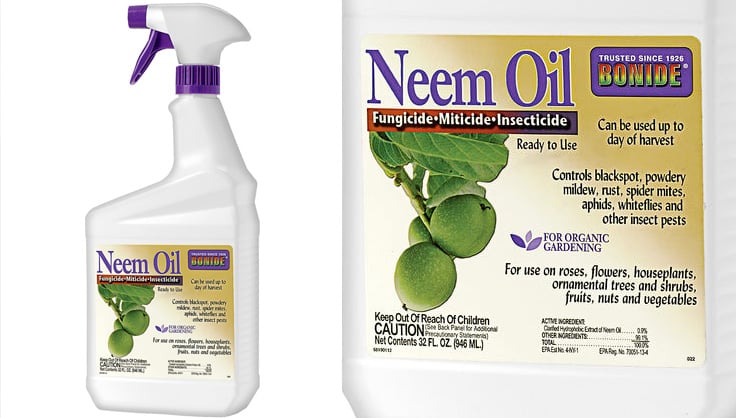 Neem Oil Spray, derived from the seed of the tropical neem tree, is a remarkable, multipurpose pest control spray. It works on a wide variety of pests, including houseplant pests, such as aphids, spidermites, mealybugs, and scale. It also controls diseases, such as powdery mildew.
Neem Oil Spray, derived from the seed of the tropical neem tree, is a remarkable, multipurpose pest control spray. It works on a wide variety of pests, including houseplant pests, such as aphids, spidermites, mealybugs, and scale. It also controls diseases, such as powdery mildew.
Print this Article:
Get the Dirt
Stay up to date on new articles and advice. Please fill out the information below.
